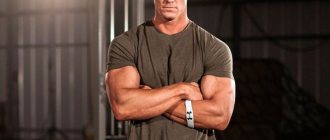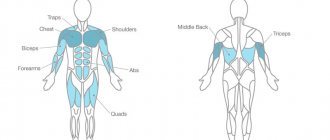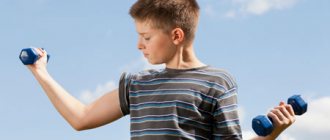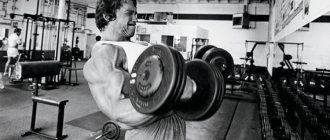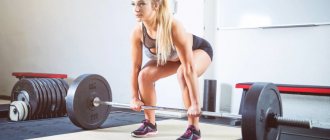© luckybusiness — stock.adobe.com
Share:
What you need
- Dumbbells
- Barbell
- Horizontal bar
- Exercise equipment
- Fitball
We often hear from various fitness bloggers that without doing basic exercises there can be no growth. What confirms their effectiveness? In this article we will try to answer this question, and also figure out how to do basic basic exercises and how to implement them into your training process.
The best basic exercises for different muscles
There are both basic and isolation exercises for each muscle group. It is especially important to perform basic exercises for beginner athletes. This way, you will quickly build a certain strength base, from which it will later be easier for you to build muscle, improve the functionality of your body, or increase record weights in strength movements. But it is not recommended for experienced athletes to abandon the base; in any case, it should make up the majority of your program.
It is worth noting that not all athletes will benefit from regular exercise. Many of them (such as deadlifts and squats) involve a strong axial load on the spine. It is not recommended to perform them for herniated discs and protrusions, especially in the lumbar region. In addition, performing these exercises with large working weights is quite a traumatic activity, and the slightest deviation from the correct technique can not only aggravate existing health problems, but also cause new ones to arise.
For beginners who train without a trainer, it is also better not to include deadlifts and squats with a barbell in their program, since learning the technique from scratch on your own will be quite difficult. It is better to first develop skills in working with iron using simpler basic exercises, and only then move on to complex ones. Or immediately start working with a trainer.
Below we provide a list of basic exercises for each muscle group. They are suitable for both men and women, the most important thing about them is the correct technique.
How many sets and repetitions should you do?
If you do an exercise with a high number of repetitions (15-20), the endurance of the trained muscles increases. With an average number of repetitions (8-12), muscle volume and strength increase. Well, if you train with a low number of repetitions and heavy weights, then your strength indicators will increase significantly. Now you understand why powerlifters train with maximum weights for 1-3 repetitions per set, because their main goal is to become stronger and at the same time gain minimal body weight.
For a beginner athlete, the optimal number of repetitions is from 8 to 12 in each approach. After working out for a month or two according to the program for beginners, you will understand what number of repetitions is right for you. Because the same number of repetitions affects different people differently. In any case, if you have completed the maximum number of repetitions in all approaches, then it is time to add weight to the bar. Yes, there is also a point that different muscle groups in one person react to different numbers of repetitions. This must also be remembered.
Next, we’ll look at the number of approaches for each muscle group. For myself, I developed the following scheme: the first 2-3 approaches are warm-up, then 3-4 approaches are working (depending on the weights).
The basic rule is this: there should always be warm-up approaches. I often had to watch a young athlete rush into the gym, run up to the bench press, hang 70-80-90 kg on the bar and begin to squirm under the bar as if in a frying pan. If you are a serious person, never do this.
So, the first approach is always a warm-up. I always do the first approach with an empty bar for 15-20 repetitions in almost every exercise. Then I add a few kilograms (or tens of kilograms, depending on the exercise) and do a second warm-up set of 12-15 repetitions.
Sometimes I do a third warm-up set if the working weights are heavy enough (I add a couple more plates to the bar and do 10 reps). During these 2-3 approaches, your muscles will warm up well, fill with blood, and prepare for more serious loads; the ligaments will stretch and become more elastic. Perform all warm-up approaches at an average pace with correct technique.
Working approaches follow. I usually do three working sets of 8-10 reps. The exercise is performed at an average pace with impeccable technique. If you can't perform all 10 reps well, then the weight on the bar is too heavy. Lose a couple of kilos and do the next set.
Let's also touch on the concept of refusal. This is the point in the set after which you are unable to perform another repetition on your own. This is called working to failure. Ideally, the last rep of each set should be a “failure.” It is these repetitions to failure that are believed to cause stress changes in muscle tissue and trigger muscle growth processes. When working to failure in basic exercises, always ask a friend to back you up.
The last thing to pay attention to is rest between sets. Classically in bodybuilding, 1-1.5 minutes of rest between sets is considered optimal.
If you are training in a powerlifting program (with near-limit weights), then the rest may take 5 minutes or more.
I hope this article will be useful to you, and you will correctly determine the required number of approaches and repetitions. Yes, don’t forget to subscribe to blog updates and receive the latest articles in your email.
PS. By the way, I advise you to familiarize yourself with the nuances of the technique of basic exercises in video format.
Basic leg exercises
Let's first talk about basic leg exercises. After all, many ignore this muscle group, but in vain.
Squats
Barbell squats are one of the fundamental exercises in many sports. In this movement, almost all muscle groups of your body work in one way or another. The main dynamic load falls on the quadriceps, hamstrings, spinal extensors, gluteal muscles and hip adductors. When working with serious weight, a significant static load falls on the abdominal muscles, shoulders and trapezius muscles.
The main thing in this exercise is to monitor your breathing (exhale strictly when lifting) and keep your back straight throughout the entire movement - this way you will protect yourself from injury.
© Vitaly Sova — stock.adobe.com
A clear position of the head helps stabilize the movement - the gaze should be directed strictly in front of you or slightly upward, this will make it psychologically easier for you to get up from a lower position.
Don't forget about the position of your feet - in general, they should be spaced slightly wider than your shoulders, with your toes pointing to the sides. When rising from a squat, never bring your knees together.
This also includes squats in Smith and hack machine. These movements are a little simpler in terms of technique. The general principle is the same, but the position of the body and the projectile is more fixed, which is why fewer stabilizer muscles are involved in the work.
© mountaira — stock.adobe.com
Leg press
The platform leg press cannot fully replace heavy squats with a barbell, but the load on the legs is no less: the front, back and inner thighs and gluteal muscles work. Perfect for beginners for whom the squat technique will be too difficult at the initial stage.
The most important thing in this exercise is not to overdo it with the working weight. This will make it more difficult for you to control the correct position of your knees. If you bring them inside the trajectory of movement, you risk injury to the ligaments.
It is also important to work in a comfortable amplitude. Do not try to lower the platform as low as possible. The geometry of most exercise machines is designed in such a way that at the lowest point your spine will be rounded in the tailbone area. This is an extremely traumatic position. At the top point, you don’t need to straighten your knees all the way, leave them slightly bent.
Lunges
You can perform lunges with your own weight, with a barbell or dumbbells. In any variation, you will use all areas of the leg muscles. Depending on the width of the step, the direction of movement and the position of the foot, you can slightly emphasize the load on one or another area: with a shorter step, the emphasis falls on the quadriceps, with a wide one, on the hamstrings.
If you perform a step in such a way that at the bottom point the angle between the shin and the thigh of both legs is 90 degrees, the load is equally distributed on the front and back surfaces of the thigh.
Sumo deadlift
This is a variation of the classic deadlift, in which the emphasis shifts to the legs (adductors, quadriceps and hamstrings) and works the back to a lesser extent. This is achieved through wider stance of the legs. The range of motion in a sumo stance is a little shorter, but this does not eliminate the powerful static tension in the abdominal muscles, back, trapezius and arms.
The correct technique for performing a sumo deadlift involves a deep squat in the starting position and maintaining a straight back throughout the entire exercise. This way you minimize the risk of back injury or umbilical hernia.
Athletes who are not involved in powerlifting should avoid using an underhand grip, as it can also lead to spinal injury. Use a regular overhand grip; you can attach straps if the weight is too heavy.
Romanian deadlift
It is often mistakenly called a deadlift, although in fact a deadlift is a regular classic deadlift. In the Romanian version, the legs remain slightly bent throughout the entire approach; the work is mainly carried out by the extensors of the spine and biceps of the thigh. That is why this exercise can be considered a basic one for the back. It’s also a good idea to include the gluteal and other additional stabilizers (trapezius, calf, etc.).
There is no need to perform this movement with fully straightened legs, as this can cause injury. The angle of the knees should not change throughout the entire approach. The bend should be done to a comfortable point, stretching is different for everyone, and should not be done through pain. It is also important not to hunch your back; if you can’t do this, reduce the working weight.
Another version of this exercise is with dumbbells, the technique here is identical, but the emphasis shifts more to the gluteal muscles.
Purpose of the basic program
The basic program is suitable for different groups of trainees:
- For experienced athletes, subject to the principle of periodization of loads or rest from heavy training.
- For beginner athletes, the basics teach how to contract muscles correctly and gradually build up a strength foundation.
- Ectomorphs and mesomorphs who want to gain high-quality muscle mass.
- For girls who are seriously interested in iron sports and have not fully learned to listen to their body.
- Athletes for whom fitness and crossfit are a hobby, but not a way of life or a profession.
Pros of the basic program
The main advantages of such training:
- Performing heavy multi-joint movements stimulates the growth of large and small muscle groups and an increase in strength.
- Save time. You don’t spend a lot of time doing isolated exercises; the duration of the workout is reduced by 1.5-2 times.
- Almost a complete guarantee that you will not overtrain. Often, beginning athletes add a lot of isolation to the program in addition to the basics; as a result, the muscles receive excessive stress, do not have time to recover and do not grow.
Disadvantages of the program
However, the basic weight training program is not without its disadvantages:
- Most basic exercises are dangerous. For example, bench presses can injure your wrists, elbows, and shoulders, while barbell squats can injure your knees or back.
- Some athletes have a predisposition to hypertrophy of the oblique abdominal muscles. Constantly doing the base will only make it worse. The result is a wide waist and the risk of an umbilical hernia. But this is subject to working with really heavy weights (for example, deadlift from 200 kg).
- Psychological factor. It is difficult to set yourself up for monotonous hard work in multi-joint exercises day after day: most athletes find it much easier to do isolated exercises - they do not load the central nervous system so much.
Basic exercises for the back
Now let's talk about how to achieve a powerful muscle corset and rock your back.
Pull-ups on the horizontal bar
The crossbar is a wonderful exercise machine with which you can work the entire muscle mass of the upper back. If you do a wide-grip pull-up, the work involves the latissimus dorsi, trapezius and rhomboids, the posterior deltoid muscles, as well as the teres major and minor muscles.
If you use a narrower grip, the arm muscles will be strongly involved in the work: biceps, brachialis and forearms. To partially reduce the load on your arms, use wrist straps. If you want to stress your back muscles even more, do a slight arch in the thoracic spine and squeeze your shoulder blades together at the top of the amplitude.
Pull-ups (as well as pull-downs on a vertical block) are recommended to be performed only by people with a flexible shoulder girdle. In general, it is better to perform this movement towards the chest to avoid injury to the shoulder joints.
This group of exercises includes all vertical rows on a block, as well as pull-ups on a gravitron - this is a special exercise machine with a counterweight that facilitates movement. Pulldowns use the same muscles, but are slightly less effective. They are well suited for beginners who do not have enough strength to pull themselves up, as well as for those who do not know how to “turn on” their back and pull themselves up using their arm muscles.
© Makatserchyk — stock.adobe.com
Bent-over barbell or dumbbell row
Horizontal rows thicken your back, which is important for building a massive torso. Bent-over barbell rows target the entire upper back, rear deltoids, and biceps. Also, a strong static load is placed on the spinal extensors and abdominal muscles.
Experienced athletes can focus the load on one or another area of the latissimus muscles. If you want to put more stress on your lower lats, use a reverse grip and pull the bar straight toward your waist. If your goal is a strong upper lat, rhomboid, and trapezius, work with an overhand grip and lift the barbell toward the bottom of your ribcage.
The tilt is also important; many athletes lean forward only a little, which reduces the range of motion and places emphasis on the trapezius. It is optimal to bend to an angle of approximately 30 degrees relative to the floor.
© Makatserchyk — stock.adobe.com
Bent-over dumbbell rows help pump up your back just as well. This is a one-way movement, so the stabilizer muscles will work even more here: the spinal extensors, abs and deltoids. It is recommended to perform both of these exercises with moderate weight and not to use cheating (swinging the body). It is much more important to engage the back muscles as much as possible, bringing the shoulder blades together at the top point, than to try to throw a barbell or dumbbell up in every possible way.
This also includes rowing a barbell to the waist while lying on an inclined bench. This exercise is good because the static position of the body eliminates cheating and also reduces the load on the lower back. The working weight is taken less than with a regular standing deadlift.
© Makatserchyk — stock.adobe.com
Another variation is traction on a horizontal block. It also targets the thickness of the back and uses the same muscle groups. If you take a wide handle instead of a narrow one and take it wider than your shoulders, you can shift the emphasis to the rear deltoid.
© tankist276 — stock.adobe.com
T-bar row
Almost every modern gym has a special machine for working out the back muscles - the T-bar. They come in two types: with and without chest support. A variation of the T-bar row with a chest support allows you to almost completely imitate the performance of a bent-over barbell row while lying on an incline bench.
Another plus of this machine is that there are more grip variations. For example, a narrow parallel grip allows you to perfectly work the middle of the back; you cannot imitate such a movement by working only with a barbell or dumbbells.
If your gym doesn’t have such a machine, it doesn’t matter. You can imitate the T-bar row using a regular Olympic barbell and a handle with a narrow parallel grip from a block back machine. In any case, this exercise is worth doing on a regular basis - your back will quickly become more lumpy and massive.
Classic deadlift
Deadlifts with classic leg positioning involve shifting the load to the back muscles. However, the legs are also involved quite strongly, and although this movement is traditionally classified as a back exercise, it can also be considered basic for the legs.
The classic stance involves placing your feet shoulder-width apart, your hands holding the barbell a little wider, and doing a slight squat and leaning forward. Keep the barbell as close to your shin as possible, then the trajectory of movement will be strictly vertical. The legs work here only at the moment the bar lifts off the floor; mainly the buttocks and quadriceps work. But you go through the upper 2/3 of the amplitude due to the work of the spinal extensors. A strong static load falls on all the muscles of the upper back, trapezius and biceps.
It is fundamentally important to keep your back straight throughout the entire approach.
Performing hump deadlifts is one of the most common mistakes among beginner athletes, but under no circumstances should you lift serious weight this way, it can put an end to your sports career.
It is very important to breathe properly while performing deadlifts. Exhaling too late will increase intracranial pressure, which can make you feel dizzy and may force you to stop your workout.
If you want to increase your strength and work on the upper phase of the movement, perform deadlifts from plinths (stands). This will reduce the load on your legs to almost zero, and you will be able to pump your back even more.
Basic chest exercises
Bench press
The bench press is probably the most common exercise in all gyms. This exercise cannot be called isolated; the triceps and shoulders work here no less than the pectoral muscles. The static load falls on the spinal extensors, latissimus and trapezius muscles of the back, biceps and abdominal muscles.
Many athletes squeeze their shoulder blades together as much as possible, arch their lower back, bridge and use a wide grip - this shortens the range of motion and further reduces the load on the chest muscles. This makes no sense unless you are into powerlifting. It would be optimal to bring your shoulder blades together and make a slight natural deflection. In this case, the legs rest on the entire foot, and not on the toes.
You can perform the barbell press on an incline bench or lying upside down. This focuses the load on the top or bottom of the chest, respectively, but the load on the triceps and front deltoids will not disappear. If the positive angle is too large (more than 45 degrees), the emphasis shifts from the upper chest to the deltoids. The optimal angle is 30 degrees.
© Makatserchyk — stock.adobe.com
Smith bench presses can also be included in this category. The trajectory of movement here is set by the simulator itself, so fewer stabilizer muscles are activated.
© Odua Images - stock.adobe.com
Dumbbell Bench Press
A similar exercise to the barbell bench press. There are also three main variations - bench press on a horizontal bench, inclined and upside down.
Due to the fact that a separate projectile is held in each hand, more small stabilizer muscles are connected. You can also increase the amplitude by lowering the dumbbells a little lower; you won’t be able to do this with a barbell.
When creating a training program, a great option would be to combine barbell and dumbbell presses at different angles, for example, first perform a barbell press on a regular bench, and then do dumbbells on an incline.
© Makatserchyk — stock.adobe.com
Dips
Dips are an equally effective exercise for working the lower chest, but they also work the triceps and anterior deltoids just as much. The correct position of the body and elbows will help you focus on working one or another muscle group. If you spread your elbows to the sides and bend forward slightly, your pectoral muscles will work harder. If you keep your back straight and move your elbows along your body - triceps. It is also recommended to use slightly narrower bars to emphasize the triceps. In this variation, this exercise will be basic for the arms.
If necessary, use additional weights in the form of a disk or dumbbell suspended from your belt.
Pushups
The simplest chest exercise that you can do even at home. However, it is basic, because in addition to the chest, it also uses the triceps and the anterior delta.
In push-ups, you can also focus on a specific muscle group. In the case of the chest, the position of the arms should be wider than the shoulders, with the elbows spread to the side.
For greater amplitude, use supports under your arms; you can perform the movement on dumbbells or kettlebells.
© kucherav — stock.adobe.com
To shift the load to the upper chest, the legs should stand at some elevation.
If you want to place more emphasis on the triceps, then place your arms narrower than your shoulders, almost close, with your palms facing each other. When lowering, your elbows should be guided along the body. In this version, this exercise can be classified as a triceps exercise.
© Roman Stetsyk — stock.adobe.com
Here you can also use additional weights, such as a heavy backpack.
Basic hand exercises
In addition to the above-mentioned variations of push-ups and parallel bars for triceps, let's look at a few more exercises.
Close grip bench press
This is a fundamental movement for triceps growth. Here all three of its bundles work evenly, as well as the inner part of the pectoral muscles and the anterior deltoids. When performing a bench press with a close grip, it is important to extend your arms in the same trajectory. To do this, concentrate on the position of your elbows; they should be pressed to the body all the time.
The triceps is a fairly stubborn muscle. In order for it to grow, you need to do both strength work and simply pump blood into the muscle in a higher repetition mode. That is why, when gaining muscle mass, it is recommended to focus on this movement, supplementing it with 1-2 isolating exercises.
Close-grip pull-ups
The only basic exercise for biceps. All other movements in this group are variations of arm curls with a barbell, dumbbells or on machines. They involve only the elbow joint and only one muscle group, which is why they are classified as isolation.
Close-grip pull-ups also work your back muscles well. To emphasize the load on the biceps, do not use straps, try not to squeeze your shoulder blades and pull up using the strength of your arms.
How and how many times a week you need to pump your biceps
The biceps is a small muscle group, and it needs much less time for rest and recovery than, for example, the back muscles, so there is truth in Arnie’s words.
But here you need to pay attention to this:
1
If your biceps are growing well, you don’t need to devote too much time to it, it’s better to pay attention to lagging muscle groups (read the article “specialization”)
2
Your split is important (I hope you know what it is. If not, read the article Split-separate workouts on the website”), that is, which muscle group the biceps are trained with
If the biceps is trained together with the back muscles, there is no way to work it well, since it is involved in almost all back exercises. Primary muscle fatigue occurs. It turns out that when you approach exercises for the biceps, it can no longer handle heavy weights.
In this case, it is worth adding one more workout per week for the biceps. On the day when the biceps are trained together with the back, perform exercises with light (50-60% of working) weights and 10-12 repetitions.
3. On a separate day, train your biceps hard, using heavy weights, cheats and reps in the range of 8-10.
This way you get two workouts per week.
4. If you train your biceps separately from your back, then work them hard during this workout. On the day of the back workout, the biceps will receive additional load, which will be the second workout.
5. It is necessary that at least two days pass between workouts so that the biceps muscles can recover at least partially. Therefore, there is no need to put a biceps training day immediately after a back training day, or vice versa.
6. It is better to do a heavy biceps workout at the beginning of the week, and a light one at the end. There should be 2-3 days between them.
7. Analyze your feelings. If you feel that you don’t have time to recover, or the working weights in biceps or back exercises have dropped, change the split. A drop in working weights will mean that you have not correctly planned your training plan for the week, and your biceps need more time to rest.
8. Do not overload your biceps workout with too many exercises. If you are a beginner, barbell curls will be enough to get you started.
9. After training for several months, you can add another exercise, for example, lifting dumbbells for biceps with a hammer.
To summarize: you need to train your biceps twice a week. Of these, one workout should be hard and one easy.
You will find exercises and techniques for performing them on the “Biceps Exercises” page.
Basic shoulder exercises
Let's look at the most effective exercises that will help strengthen your shoulders.
Bench press standing or seated
In this movement, you work all three deltoids, triceps, and a little of the upper chest. But in any presses up (even from behind the head), only the front bundle receives the greatest load.
In addition, the standing press is very important for developing control over the entire body, because all other muscle groups play the role of stabilizers to one degree or another.
This movement places a fairly strong axial load on the spine, so it is recommended not to push for record weights and, if necessary, use an athletic belt. If you want to reduce the stress on your lower back, do the seated barbell press instead. But even here the load is not completely eliminated - with a sufficiently heavy barbell, the athlete automatically bends in the lower back.
There are still numerous debates regarding the correct way to lower the barbell: behind your head or in front of you. The beam that works here is the same – the front one. But lowering behind the head is an extremely dangerous movement for the shoulder joints. If you don't have some flexibility in your shoulder girdle, you are more likely to get injured. So you should do this exercise only in the form of chest drops.
This also includes seated presses in Smith. Here the trajectory of movement is set by the design, fewer stabilizer muscles are activated, and cheating is eliminated due to a slight squat.
Dumbbell press sitting or standing
An alternative to the barbell press. There is no particular difference between the exercises, it’s mainly just a matter of individual preferences, for example, it’s easier for someone to feel the work of the deltoids with dumbbells. You can do similar presses with each hand alternately or use weights for this.
© Makatserchyk — stock.adobe.com
A variation of this exercise is the Arnold press - when the dumbbells are turned towards you when lowered. Thanks to this, the rotator cuff muscles are also involved.
Barbell row to the chin
Despite the fact that the target muscle group when performing a barbell row to the chin is the middle delta, this row (or simply a pull-up) should be considered the base. In addition to the middle delta, the biceps, forearms and trapezius muscles also actively work here. With a narrow grip, the emphasis shifts from the middle to the front delts.
Regular stretching will help you create broad shoulders and add bulk to your entire upper body. There is only one thing - do not overdo it with the working weight. 40-50 kg is the weight with which experienced athletes with impressive muscle mass perform chin pulls. If your training experience is still short, do not run ahead of the train, limit yourself to working with an empty bar, this will be much more useful.
If you don’t have a barbell, the movement can be performed with dumbbells.
© ruigsantos — stock.adobe.com
Wave-like periodization
The method involves alternating the number of repetitions performed. They are divided into three groups that need to be alternated, and each of them affects the growth of muscle fibers in different ways:
A small number of repetitions (from 1 to 6) - such a small number is useful for athletes who want to work with heavy weights, thereby maximizing the load on the muscles and reducing the risk of sports injury. In addition, the myofibril threads are destroyed, which entails an acceleration of subsequent regeneration and an increase in strength. The range is recommended for use by amateurs and beginners who increase their working weight.
An acceptable number of repetitions (from 7 to 11) - the load time lasts about 30 seconds. It is believed that this quantity is the most acceptable to achieve muscle growth in any part of the human body. Unlike the low rep range outlined above, the medium rep range allows you to achieve results much faster. However, the “golden mean” lies between medium and low execution; only if both techniques are performed, it is possible to increase the working, as well as the maximum weight.
A large number of repetitions (from 12) is unlikely to allow the athlete to build muscle mass; sometimes, on the contrary, weight begins to go away under the influence of this type of training, since strength training smoothly turns into cardio, loading muscle groups to the point of exhaustion.
A real “chemical boom” occurs inside the cells, as the number of mitochondria begins to increase, and accordingly muscle endurance increases. Professionals recommend developing in this direction, since having strength alone is not enough; you also need endurance.
Proper training is the key to gaining muscle mass. The leading principle is the exclusion of muscle adaptation to the loads performed by the athlete. Alternate between different ranges in drop sets, split sets and super sets. It will be effective to perform the so-called “failure repetition”, when you simply work to failure.
When selecting the necessary numbers, you need to pay attention to the fact that each muscle group has its own recovery time, limits, and anatomical features. All of the above exercises are relevant, including for women, only performed with other weights with a predominance of super-sets
Shoulder workout
The deltoid muscle covers the entire shoulder joint, being the main muscle. In addition to it, there is also a posterior group of muscles starting from the scapula, while being attached directly to the humerus. Achieving targeted growth of the posterior group is very difficult, and therefore is not used in practice.
The deltoid muscle consists of three bundles (anterior, middle, posterior). However, any training is capable of using all the bundles at once. Shoulder training is recommended to be performed with maximum, medium repetitions.
Arm training
As a rule, the arms are loaded in order, first performing exercises on the biceps, brachialis, brachioradialis muscles, and then achieving the triceps. Things are different here. From an anatomical point of view, the biceps muscle has more stable tendons and a tendency to handle heavier weights. When creating a training plan, it is best to use “unliftable” weights, training in a low range.
Biceps, like everything connected with it, recovers within 48 hours, sometimes more. When working out in the gym, try to get the most out of your reps. Triceps training is carried out in a similar way.
Leg workout
The strongest muscle in the legs is the quadriceps (How to pump up the quadriceps) or the femoral muscle. It is represented by four bundles that “envelop” the leg. The training should be to the last drop of sweat, since it “clogs” very quickly and is restored slowly.
Basic abdominal exercises
There are hundreds of abdominal exercises. Most of them can technically be classified as basic - since flexion/extension of the spine and hip joints occurs, and several muscle groups are involved in the movement in one way or another. Below we present some of the most popular and effective ones.
Hanging leg raises on the bar
This exercise works great on both the lower and upper rectus abdominis muscles. The lower part of the press receives a slightly greater load.
Usually, during the period of gaining muscle mass, to maintain strength tone in the abdominal muscles, it is enough to perform just one movement, because they already receive enough load from heavy squats, deadlifts and bent-over rows. Therefore, for this purpose, lifting the legs (or knees) while hanging is perfect.
Crunches
There are many variations of this exercise, but they are all aimed at performing the main anatomical function of the abdominal muscles - twisting the body. It is important not to confuse crunches with sit-ups. Here we are not just lifting the body, but rounding the thoracic spine - it is this movement that ensures maximum contraction of the rectus abdominis muscle.
The easiest option is on the floor without weights:
A little more complex - on a fitball:
© Makatserchyk — stock.adobe.com
Even more difficult - with legs raised:
© chika_milan — stock.adobe.com
For athletes with training experience and strong abs, it is better to perform crunches with additional weights:
© fizkes — stock.adobe.com
Training program for gaining weight
For anyone looking to gain large amounts of muscle mass, one of their top priorities should be figuring out the best training program. There are many different training programs available, so it is important to choose one that suits your needs.
It is also important to understand what factors contribute most to muscle growth, what exercises are most effective for gaining muscle mass, and a program based on these principles will be much more effective.
We have collected for you the best weight training programs that show amazing results with the right approach. Let's take a quick look at the most effective and popular strength training programs and identify the pros and cons of each.
A set of basic exercises for men
This workout with basic exercises is a classic three-day split (working different muscle groups on specific days of the week). You can use it at any stage of training, but you will get the greatest results from it during the period of mass gain.
| Muscles trained | Exercises | Number of approaches and repetitions |
| Chest + triceps + shoulders | Bench press on a horizontal bench | 4х12,10,8,6 |
| Incline Dumbbell Press | 3x10-12 | |
| Dips with extra weight | 3x10-12 | |
| Close grip bench press | 4x10 | |
| Arnold press | 4x10-12 | |
| Wide grip barbell row | 4x12 | |
| Back + biceps | Deadlift | 4х12,10,8,6 |
| Wide grip pull-ups | 4x10-15 | |
| Bent-over barbell row | 3x10 | |
| Bent-over dumbbell row | 3x10 | |
| Close-grip pull-ups | 4x10-15 | |
| Legs + abs | Squats | 4х12,10,8,6 |
| Leg press | 4x10-12 | |
| Lunges with a barbell, wide steps | 4x10 | |
| Standing calf raises in the machine | 4x15 | |
| Crunches on a fitball | 3x12-15 | |
| Hanging Leg Raise | 3x10-15 |
Mass training program 3 times a week
Workout "A"
| Exercise | Approaches | Repetitions |
| Warm-up | ||
| A. Lifting and pressing dumbbells Try to reduce rest time | 5 | 5 |
| B. Barbell Squats Increase the weight with each set. | 2 | 10 |
| C. Straight-legged deadlift | 1 | 20 |
| D. Chest rows using a machine or block. Try to keep the tension in a positive phase. Work as intensely as possible. | 5 | 5 |
| E. Pull-ups Do as many sets as necessary to complete 25 reps. If you find it too easy, use additional weight. | 25 | |
| F. Bench Press Try to finish your last set feeling like you could have done a couple more reps. | 3 | 5 |
| G. Barbell Curls Gradually increase the weight with each set. | 3 | 5 |
| H. Farmer's Walk Perform 1 set with heavy dumbbells. Try to finish your set at the dumbbell rack. | 1 |
Workout "B"
| Exercise | Approaches | Repetitions |
| Warm-up | ||
| A. Lifting and pressing dumbbells Try to reduce rest time | 3 | 5 |
| B. Barbell Squats On the second set, increase the working weight. This is preparation for training "C" | 2 | 10 |
| C. Straight-legged deadlift | 1 | 20 |
| D. Pulldown Work less intensely than in workout “A” | 3 | 5 |
| E. Pull-ups Do as many sets as needed to complete 15 reps. If it's too easy for you, use weights | 15 | |
| F. Bench Press Before performing the 5 prescribed sets, do a couple of warm-up reps. All approaches should be relatively heavy. | 5 | 5 |
| G. Barbell Curls You should feel a burning and pumping sensation in your muscles. | 3 | 10 |
| H. Farmer's Walk Walk as far away from the dumbbell rack as possible, lower the dumbbells to the floor, rest, and then come back. | 2 |
Workout "C"
| Exercise | Approaches | Repetitions |
| Warm-up | ||
| A. Lifting and pressing dumbbells Try to reduce rest time | 3 | 5 |
| B. Barbell Squats Increase the weight with each set. The last approach should be the hardest. | 5 | 10 |
| C. Straight-legged deadlift | 1 | 20 |
| D. Pulling the block to the chest Try to keep the tension in a positive phase. Work as hard as possible. | 2 | 5 |
| E. Pull-ups Do as many sets as needed to complete 12 reps. But it is advisable to do them in one approach. If you feel you can do much more, use additional weight. | 12 | |
| F. Bench Press Try to finish your last set feeling like you could have done a couple more reps. | 5 | 5 |
| G. Barbell curls 2 sets of 5 reps + 1 set of 10 reps. A great combination - first you work on strength, and then on pumping | 2/1 | 5/10 |
| N. Farmer's Walk Try to increase the working weight every week. Give your best. Go a long distance, stop, take a breath and try to go a little further. Don't forget that you need to make the return trip. | 2 |
